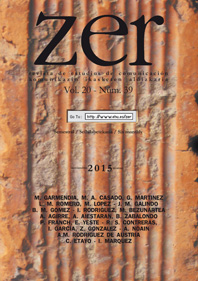El código de producción de Hollywood (1930-1966): censura, marcos (frames) y hegemonía.
##plugins.themes.bootstrap3.article.main##
##plugins.themes.bootstrap3.article.sidebar##
Publicado
09-12-2015
Alfonso Maximiliano Rodríguez de Austria
Resumen
Contrariamente a la opinión convencional, el Código de Producción de Hollywood no fue una imposición de la Iglesia católica. Las fuerzas que lo implantaron eran más numerosas y poderosas, y su objetivo principal era mantener su hegemonía sobre la sociedad en un momento en que se estaba debilitando. Una de las claves principales para la defensa del statu quo económico e ideológico era la creación de marcos primarios de referencia que sirviesen para interpretar de una forma unívoca los problemas sociales. En el presente trabajo tratamos la instauración del código desde la perspectiva del análisis de estos marcos (frame analysis).
Cómo citar
Rodríguez de Austria, A. M. (2015). El código de producción de Hollywood (1930-1966): censura, marcos (frames) y hegemonía. ZER. Revista De Estudios De Comunicación, 20(39). https://doi.org/10.1387/zer.15533
##plugins.themes.bootstrap3.article.details##
References
BERGER, P. y LUCKMANN, T. (1991). La construcción social de la realidad. Buenos Aires: Amorrortu.
BERNSTEIN, Richard J. (2006). El abuso del mal. La corrupción de la política y la religión desde el 11/9. Buenos Aires: katz.
BLACK, Gregory. D. (1999a). Hollywood censurado. Madrid: Cambridge University Press.
BLACK, Gregory. D. (1999b). La cruzada contra el cine (1940-1975). Madrid: Cambridge University Press.
BOBBIO, Norberto; MATTEUCCI, Nicola (1981). Diccionario de Política. Madrid: Siglo XXI.
DOHERTY, Thomas (1999). Pre-Code Hollywood. Sex, Immorality, and Insurrection in American Cinema 1930-1934. Nueva York: Columbia University Press.
GITLIN, Todd. (2003). The Whole World is Watching. Mass Media in the Making and Unmaking of the New Left. Berkeley: University of California Press.
GOFFMAN, Erving (2006). Frame Analysis. Los marcos de la experiencia. Madrid: CIS.
LAKOFF, George (2007). No pienses en un elefante. lenguaje y debate político. Madrid: Complutense.
PHILLIPS, Patrick (2007). Spectator, audience and response. En. NELMES, Jill (Ed). Introduction to Film Studies, pp. 143-172. Londres: Routledge.
POPPER, Karl (1994). La sociedad abierta y sus enemigos. Barcelona: Paidós.
MAINER, Carmen (2013). El Cine Norteamericano durante la Gran Depresión (1929-1939). Fotocinema, Revista Científica de Cine y Fotografía, nº 6, pp. 171-200.
MICEVICIUTE, Jurate (2013). Frame periodístico. un concepto puente entre la Psicología, la Sociología y la Lingüística. Zer, vol. 18, nº 35, pp. 71-96.
MILLER, Toby et al. (2005). El nuevo Hollywood. Del imperialismo cultural a las leyes de marketing. Barcelona: Paidós.
ROFFMAN, Peter; PURDY, Jim (1981). The Hollywood Social Problem Film. Madness, Despair, and Politics from the Depression to the Fifties. Indiana University Press – Bloomington.
SÁNCHEZ RUIZ, Enrique E. (2003). Hollywood y su hegemonía planetaria. Una aproximación histórico-estructural. Guadalajara, nº 28 de la Colección de Babel de la Revista Universidad de Guadalajara.
SÁDABA, Teresa (2008). Framing. el encuadre de las noticias. El binomio terrorismo-medios. Buenos Aires: La Crujía.
BERNSTEIN, Richard J. (2006). El abuso del mal. La corrupción de la política y la religión desde el 11/9. Buenos Aires: katz.
BLACK, Gregory. D. (1999a). Hollywood censurado. Madrid: Cambridge University Press.
BLACK, Gregory. D. (1999b). La cruzada contra el cine (1940-1975). Madrid: Cambridge University Press.
BOBBIO, Norberto; MATTEUCCI, Nicola (1981). Diccionario de Política. Madrid: Siglo XXI.
DOHERTY, Thomas (1999). Pre-Code Hollywood. Sex, Immorality, and Insurrection in American Cinema 1930-1934. Nueva York: Columbia University Press.
GITLIN, Todd. (2003). The Whole World is Watching. Mass Media in the Making and Unmaking of the New Left. Berkeley: University of California Press.
GOFFMAN, Erving (2006). Frame Analysis. Los marcos de la experiencia. Madrid: CIS.
LAKOFF, George (2007). No pienses en un elefante. lenguaje y debate político. Madrid: Complutense.
PHILLIPS, Patrick (2007). Spectator, audience and response. En. NELMES, Jill (Ed). Introduction to Film Studies, pp. 143-172. Londres: Routledge.
POPPER, Karl (1994). La sociedad abierta y sus enemigos. Barcelona: Paidós.
MAINER, Carmen (2013). El Cine Norteamericano durante la Gran Depresión (1929-1939). Fotocinema, Revista Científica de Cine y Fotografía, nº 6, pp. 171-200.
MICEVICIUTE, Jurate (2013). Frame periodístico. un concepto puente entre la Psicología, la Sociología y la Lingüística. Zer, vol. 18, nº 35, pp. 71-96.
MILLER, Toby et al. (2005). El nuevo Hollywood. Del imperialismo cultural a las leyes de marketing. Barcelona: Paidós.
ROFFMAN, Peter; PURDY, Jim (1981). The Hollywood Social Problem Film. Madness, Despair, and Politics from the Depression to the Fifties. Indiana University Press – Bloomington.
SÁNCHEZ RUIZ, Enrique E. (2003). Hollywood y su hegemonía planetaria. Una aproximación histórico-estructural. Guadalajara, nº 28 de la Colección de Babel de la Revista Universidad de Guadalajara.
SÁDABA, Teresa (2008). Framing. el encuadre de las noticias. El binomio terrorismo-medios. Buenos Aires: La Crujía.
Número
Sección
Artículos
(c) UPV/EHU Press

